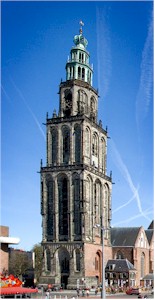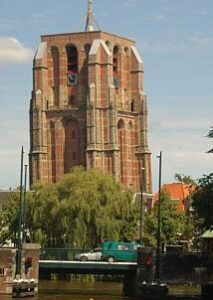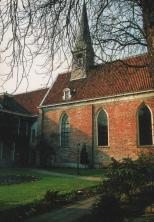While the vast majority of Huguenot refugees that came to the Netherlands settled in Amsterdam, in the early part of the 18th century the Northern Dutch City of Groningen had a substantial Huguenot community. The civic powers in Groningen were keen to establish a thriving textile manufacturing industry with the help of the many highly skilled Huguenots who had come their way. Between 1682 and 1720 the archives of the city reveal more than 1,100 names (cumulative) of French adults who are assumed to be all religious refugees, including at least 11 individuals from the Languedoc region in France.

Groningen – Martinitoren
Pierre Leignes was born in Sorèze, Languedoc, France, on November 14, 1697. He was the son of Elie Leignes and the grandson of Charles Leignes, who were “Teinturier” – or die makers – by profession in Sorèze. We do not know the exact date when he came to the Netherlands and why he settled in the city of Groningen, but while the majority of Huguenot refugees that fled to the Netherlands settled in Amsterdam, we might well assume that he went to Groningen having heard of employment opportunities in the emerging textile industry there.
However, it is more likely he went there to meet up with family members who had settled in Groningen much earlier. This included an uncle, Jacques Fabre, who, like Pierre’s mother Anne Fabre, was also from Revel in Languedoc and had arrived in Groningen towards the end of the 17th century together with his parents and sister Johanna. Already well established in the local community, Jacques Fabre was an elder in the local French church and in 1685 had obtained permission to open a coffee house.
On December 15, 1726, Pierre Leignes married Marie Madelaine Rey in the Walloon Church (Waalsche Kerk) in Groningen, and in 1728 he requested and obtained citizenship in the Netherlands. While these events took place in the Netherlands, the information found its way back to France, as referenced in this snippet from the Historical review, scientific & literary department of Tarn (former country of the Albigenses).France, Volumes 30-31:


Leeuwarden – Leaning Tower
Marie Madelaine Rey was born in Leeuwarden, in the province of Friesland, Holland, in 1693. She was the daughter of Pierre Rey, born in 1655 in Revel, Languedoc, who came to Holland in 1690, and Marie Pont (or Pons) born in 1655 (birthplace not confirmed, but most likely also Revel). Interestingly, the mother of Marie Pont was a Madeleine Leignes, the daughter of a Jaques Leignes from Revel, so there may have been already a family connection between the Rey and Leignes families in France before Marie Madelaine Rey’s marriage to Pierre Leignes in Groningen in 1726.
Prior to arriving in the Netherlands, both Pierre Rey and Marie Pont had been forced to recant their protestant faith – like so many other French protestants – following the cancellation of the Edict of Nantes in 1685. They did this in Revel, Languedoc, on Sunday 14 Monday 15 & Tuesday, October 16, 1685, together with many other protestants in their community in a mass ceremony at the local parish church.
In 1690, however, they had fled like many other Huguenots to the Netherlands and settled in Leeuwarden, in the province of Friesland. In 1701 Pierre Rey`s profession was listed as “Marchand perruquier” – (pruikemaker) or “Wig merchant”.

Groningen – Walloon Church
In 1730 Pierre Leignes was an Elder of the French or Walloon church in Groningen, and listed in church records as a “Fabrikant (Manufacturer)” by profession. Information from Groningen’s archives indicates that Pierre Leignes succeeded Jean La Carrière, a successful local entrepreneur, in a fashion shop or pharmacy that also sold such health and beauty remedies as Sirop de Capilaire a la Fleur d’Orange, in addition to Faber’s Elixer, and other popular potions of that time.
In 1755 Pierre’s son Paul Jacques Leignes (b. 1731), married Louise Jeanne La Carrière, the daughter of Jean La Carrière. They would later move to Emden, which was just across the border in Germany, following his appoinment as a minister in the French community there. In 1758 they had a daughter, Marie Madelaine Leignes, who married jhr. Victor de la Forest et de la Tour de Serière at Blegny, Trembloleur, Luik, Belgie, in 1781. They had a son in 1788, Guillaume de Serière, who, in 1841, was appointed to Governor of the Moluccas, “Molukken” in Dutch , an island group within the (then) Dutch colony of Indonesia.
Elders – or “ancien” – of the French Church in Groningen would on occasion provide written references on behalf of church members moving elsewhere but because of their refuge status had to rely on attestations such as the one co-signed by Pierre Leignes in 1735:

Letter of Attestation
Although it would seem Pierre Leignes spent most of his working life in Groningen, it appears he moved with the rest of his family to Amsterdam in his later years (around 1765), and was buried on 19-Oct-1772 at the cemetery of the Waalsche (or French) Gereformeerde Kerk in Amsterdam. The burial record also indicates that at the time of his death at age 75 he resided at the home of his son Guillaume at the Kalverstraat in Amsterdam.

Death Notice – Pierre Leignes
